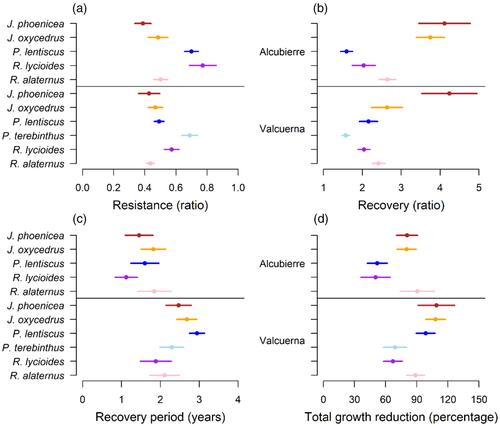Journal of Ecology ( IF 5.3 ) Pub Date : 2024-06-24 , DOI: 10.1111/1365-2745.14355 Elisa Tamudo 1 , Antonio Gazol 1 , Cristina Valeriano 1 , Ester González 1 , Michele Colangelo 2 , J. Julio Camarero 1

|
1 INTRODUCTION
Climate change is increasing the frequency, duration and intensity of droughts reducing forest growth and productivity (Lindner et al., 2010) and triggering the occurrence of dieback events in both forests and scrublands (Allen et al., 2015; Camarero et al., 2015; Colangelo et al., 2017; Hammond et al., 2022; Tamudo et al., 2021). Mediterranean forests and shrublands are considered to be vulnerable to future water shortages related to warmer conditions and increased aridity (Peñuelas & Sardans, 2021). Thus, it is necessary to generate scientific knowledge about how woody plant species respond to aridification.
Annual tree-rings represent a reliable archive of growth variation in woody plants and dendrochronology allows reconstruction of past growth patterns and how they depend on climate variability (Fritts, 1976). In the Mediterranean region, drought is considered an important driver of variability in tree and shrub radial growth (Gazol et al., 2017; Pasho et al., 2012). Drought impairs the normal functioning of woody plants and results in severe growth reductions, which can last for several years after drought cessation (Anderegg et al., 2015; Schweingruber, 1986; Veuillen et al., 2023), potentially modifying the resistance and resilience of species to future drought extremes (Bose et al., 2020). The growth resilience indices allow quantifying how woody plants respond to drought and whether they can recover pre-drought growth values (Lloret et al., 2011; Schwarz et al., 2020; Thurm et al., 2016). The resilience capacity of woody plants to drought vary between species (Gazol et al., 2017), and it is modulated by factors such as site characteristics (Gazol et al., 2020, 2022; Kannenberg et al., 2018), drought timing (Huang et al., 2018), species functional traits (Serra-Maluquer et al., 2022) and post-drought climate conditions (Veuillen et al., 2023). In trees, gymnosperms are less resistant to drought, that is they have more pervasive drought-induced growth reductions, than angiosperms (Anderegg et al., 2015), and taller tree species suffer more from drought than shorter ones (Trugmann et al., 2021). However, how shrub growth differs between species has been less studied (e.g. Gazol & Camarero, 2012; Gazol et al., 2017; Oladi et al., 2017). Thus, the more knowledge we gain on how co-occurring species respond to drought the closer we will be to understanding how they will thrive in a warmer and drier future.
The Mediterranean basin is considered a plant biodiversity hotspot (Myers et al., 2000), where historical land uses (agricultural, livestock and forestry) have profoundly altered the landscape and plant ecosystems (García-Ruiz et al., 2020). However, in some regions such as the conterminous Spain, formerly rural areas are rewilding after massive rural abandonment in the 1960s (Alfaro-Sánchez et al., 2019; Quintas-Soriano et al., 2022). This rapid rewilding is characterized by forest and shrubland encroachment, but there is a lack of data on how coexisting trees and shrubs will respond to extreme climate events such as droughts (Gazol & Camarero, 2012). Thus, knowledge of the growth responses of co-occurring trees and shrubs to climate stress is of primary importance to delimit their growth potentials in these secondary woodlands and scrublands. Particularly, we need more information on growth resilience capacity after extreme climate events such as droughts to forecast the responses of trees and shrubs to increasing aridity (Bose et al., 2020; Camarero et al., 2018; DeSoto et al., 2020).
Increasing the number of tree and shrub species showing different adaptive strategies should lead to more resilient ecosystems (Schnabel et al., 2021). In the Mediterranean region, woody species present different functional traits to deal with drought, based on different phenological, leaf, root and wood anatomical characteristics (Castro-Díez, 1996; Castro-Díez et al., 2003; Milla et al., 2010; Valeriano et al., 2023; Villar-Salvador, 2000). Species that coexist in these environments often adopt different resource use strategies, through different functional traits such as rooting depth or leaf phenology, leading to a better spatial and temporal use of limiting resources, such as water (Moreno-Gutiérrez et al., 2012; Palacio et al., 2017). Given that water availability is considered one of the main limiting factors for vegetation growth in the Mediterranean region, understanding whether there are differences in the radial growth responses to climate and drought severity of coexisting species in these environments could help to better understand their changes in structure and functioning under present and future conditions.
In this context, our main objectives were to study differences in growth patterns, responses to climate and post-drought resilience sampling six shrub species of three genera (Pistacia lentiscus L., Pistacia terebinthus L., Rhamnus alaternus L., Rhamnus lycioides L., Juniperus phoenicea L. and Juniperus oxycedrus L.) and one tree species (Pinus halepensis Mill.) co-occurring in two sites of the Monegros steppe, northeastern Spain. We selected shrublands and woodlands developed over formerly used agricultural or sparsely vegetated areas. We used dendrochronology to assess past radial growth of the studied woody species and analyse the relationships between ring width indices and climatic variability. We paid special attention to the relationship between growth and a drought index and aimed to detect differences in the short-term growth response of the studied species to dry years. We hypothesize that growth will be sensitive to water shortage resulting in growth reductions during dry years and that there will be differences in post-drought growth resilience between coexisting species and between shrubs and trees. We also expect lower growth and worse recovery after drought events in the driest site, particularly for gymnosperm species, which show stronger post-drought legacies.































 京公网安备 11010802027423号
京公网安备 11010802027423号